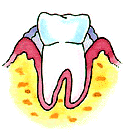| Main Causes of Gum Disease |

What Causes Gum Disease?
Periodontal diseases, such as gingivitis and periodontitis, are the main cause of tooth loss, affecting over 80% of the population above the age of 30. Poor oral hygiene and dental plaque bacteria are considered as the main causes of gum disease. Several other factors also contribute in developing periodontal diseases.
The main cause of gum disease: dental plaque bacteria
Poor oral hygiene – Bacterial overgrowth: A large amount of bacteria lives in every mouth even if it is absolutely healthy. The critical factor for the mouth to remain healthy is our ability to keep the population of mouth bacteria under control with our daily oral hygiene. Inadequate tooth brushing, that fails to remove bacteria from the surface of teeth and gums, allows the accumulation of dental plaque. If the layer of dental plaque is not removed, it starts to harden and create dental calculus which can only be removed with professional dental cleaning. Dental calculus makes the teeth surface rough, helping the tooth plaque bacteria to accumulate more easily, and making it harder to clean them with tooth brushing and flossing.
Harmful bacteria: As the thickness of dental plaque increases, the composition of dental plaque in its lower layers starts to change in favor of anaerobic bacteria. This type of bacteria is linked with the inflammatory conditions that cause periodontal diseases. The bacteria species most implicated in periodontal disease and bone loss include: Actinobacillus actinomycetemcomitans and Porphyromonas gingivalis. Other bacteria linked to gum disease are: Bacteroides forsythus, Treponema denticola, T. sokranskii and P. intermedia.
Several factors can increase the risk of developing periodontal diseases, but dental plaque is considered to be the root cause of gum diseases.
How dental plaque bacteria cause gum disease?
Although the bacteria of dental plaque are the ones that cause gum disease, the destruction of periodontal tissues is actually caused by our own body’s immune system response to chronic infections in the mouth. For this reason some researchers classify periodontal disease as one of the autoimmune disorders.
The steps of this destructive process are the following:
- Dental plaque’s composition changes from harmless aerobic bacteria towards gum disease causing anaerobic gram negative bacteria.
- Tooth plaque bacteria produce toxins causing irritation of the gingival tissues.
- Gums become red, swollen and bleed easily (gingivitis).
- Bacteria start to invade the crevices between the gum and teeth (sulcus) and infect the periodontal tissues.
- Gums inflammation causes a response from the body’s immune system, that over produces infection fighting factors called cytokines causing further inflammation.
- Immune system’s cells such as white blood cells, macrophages and lymphocytes, in their effort to fight the infection, attack the person's own infected cells and periodontal tissues.
- Cytokines trigger the production of an enzyme called collagenase, which breaks down collagen, which is a main ingredient of the jaw bone tissues surrounding teeth and the connective tissue (periodontal ligament) that holds teeth in place.
- Deep periodontal pockets are formed and irreversible bone loss occurs (periodontitis). Without proper treatment teeth will become loose and will be lost.
Other causes of gum disease include:
- Medications
- Medical conditions
- Smoking
- Human transmission
- Impacted wisdom teeth
Several other factors increase the risk for periodontal disease, by either contributing to the formation of bacterial plaque or/and by reducing the body’s ability to respond to bacterial infections.
- Dental Plaque
- Dental Calculus
- Gum Disease
- Tooth Decay
- Tooth Abscess
- Toothache
- Tooth Loss
Related Problems
- Gum Disease Treatments
- Gingivitis
Treatment - Periodontitis Treatment
- Dental Scaling & Root Planing
- Antibiotics for
Gum Disease - Gum Surgery
- Gingivectomy
- Gum Flap Surgery -
Pocket Reduction - Periodontal
Bone Grafts - Gum Grafts -
Soft Tissue Graft - Crown
Lengthening - Dental Implants
articles about
Gum Disease Treatment
